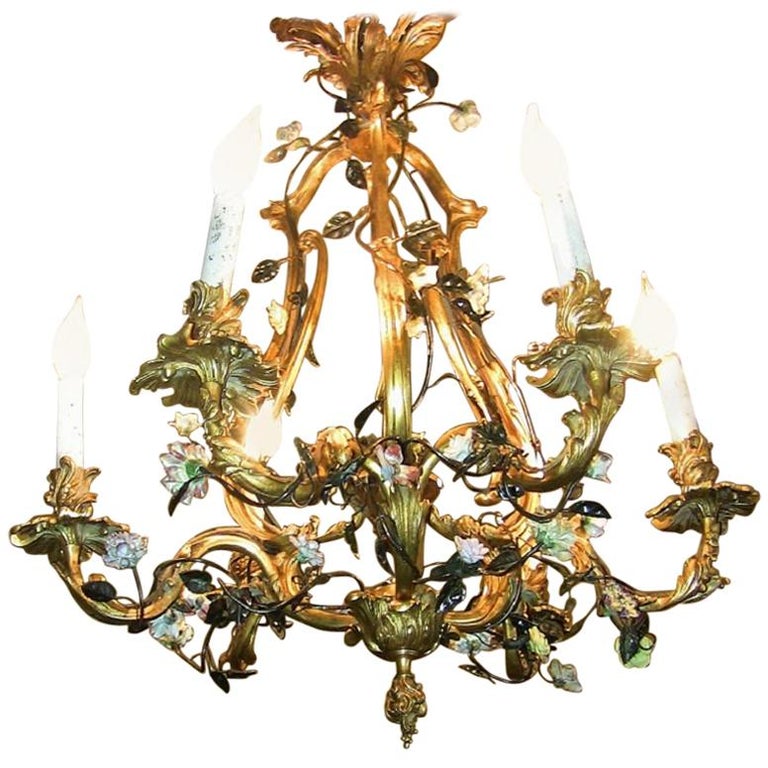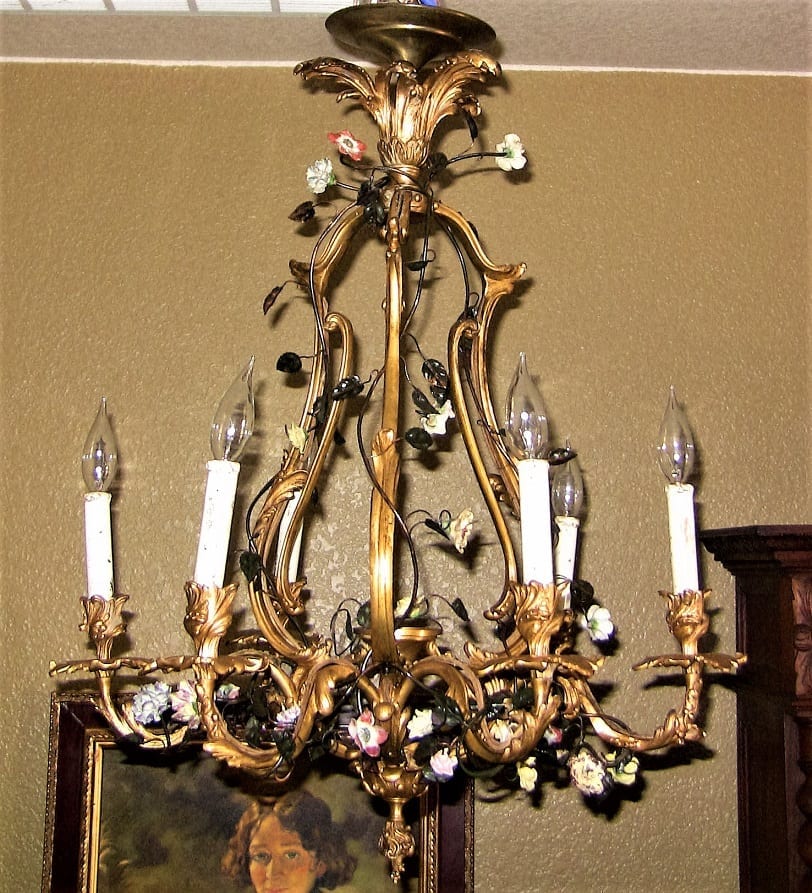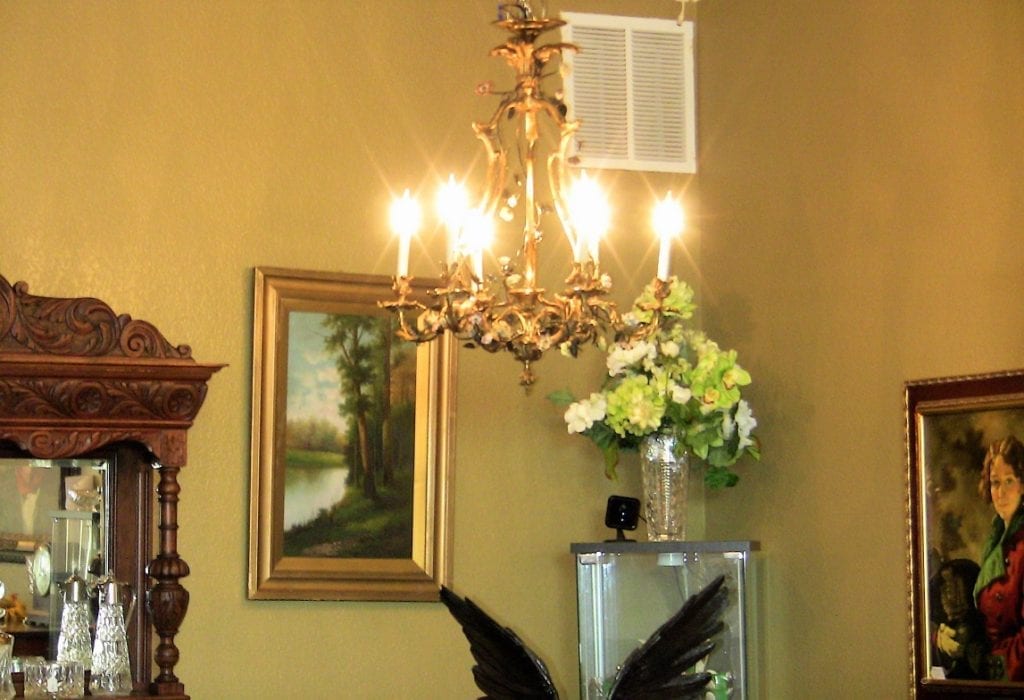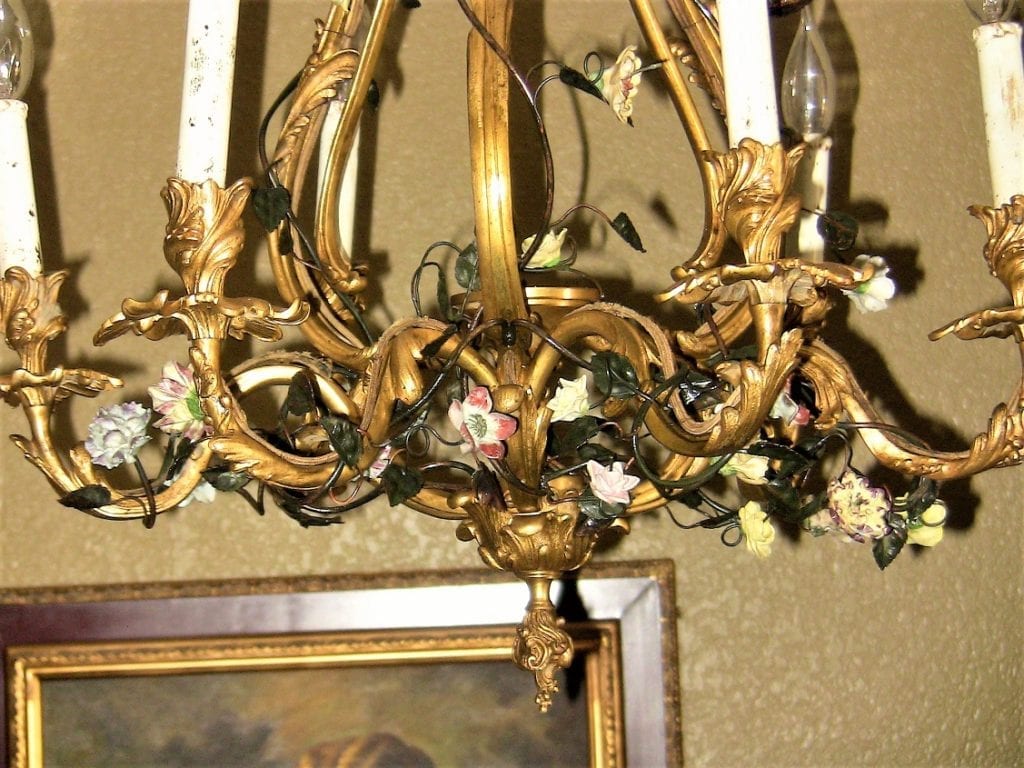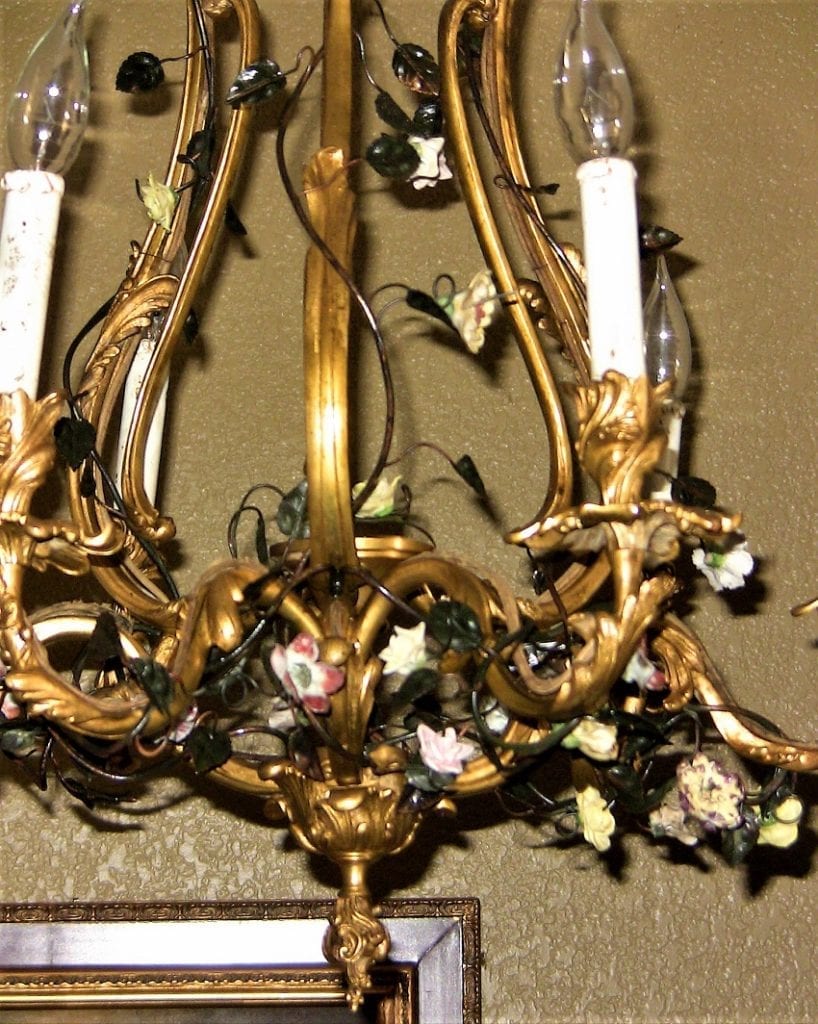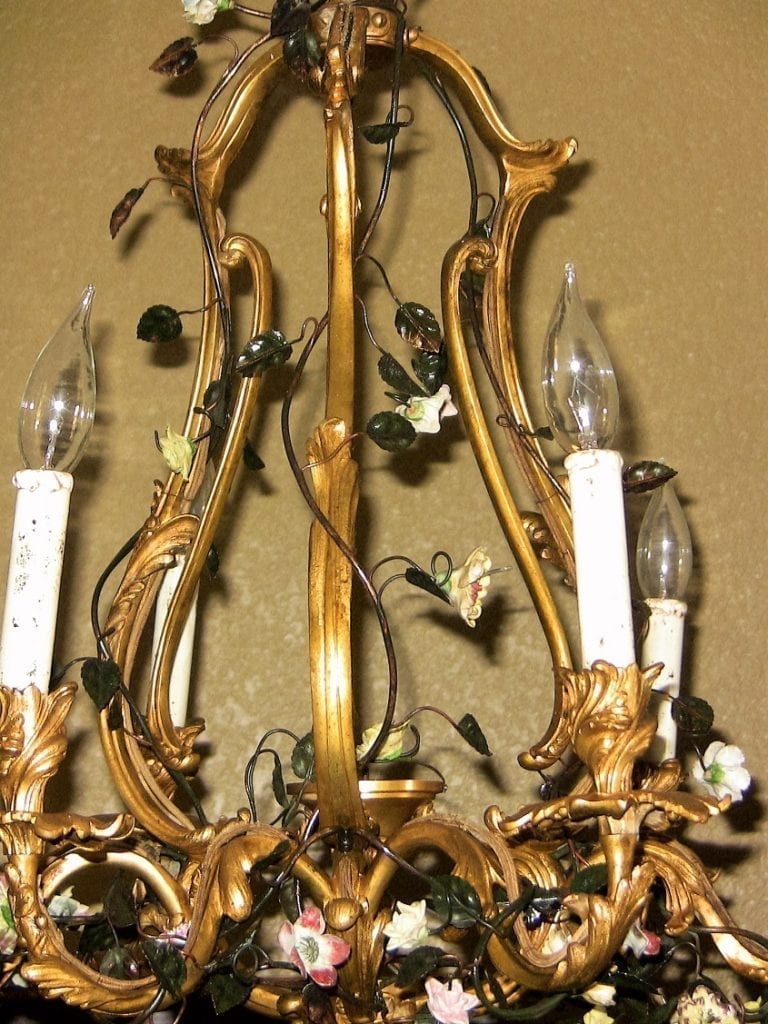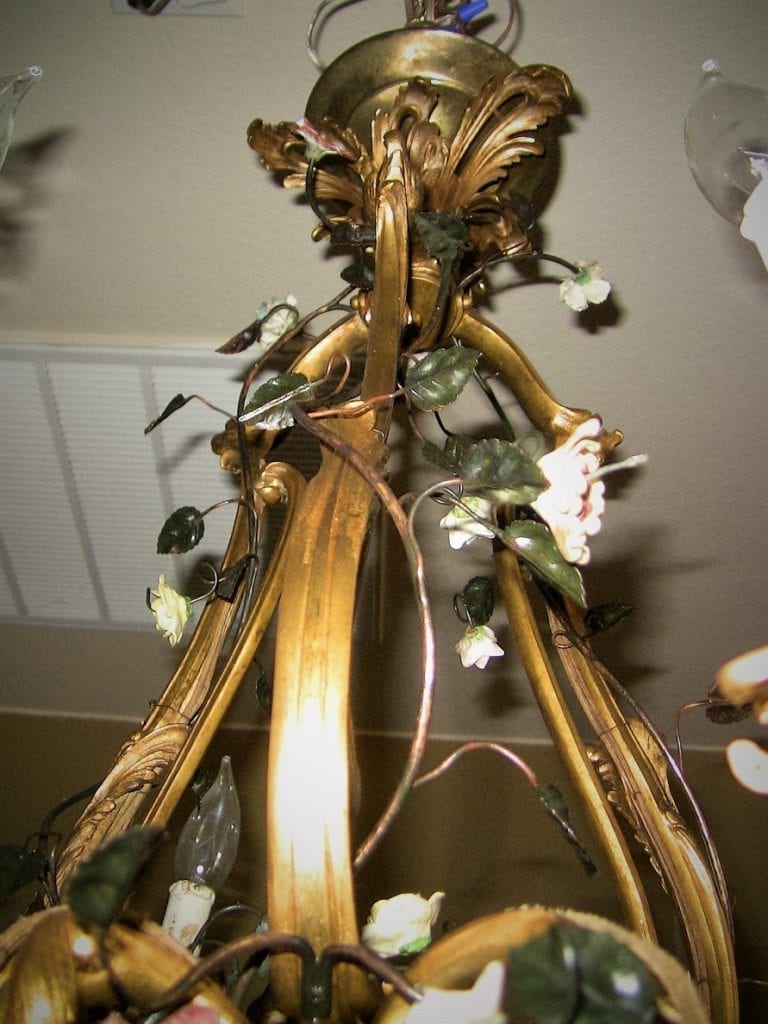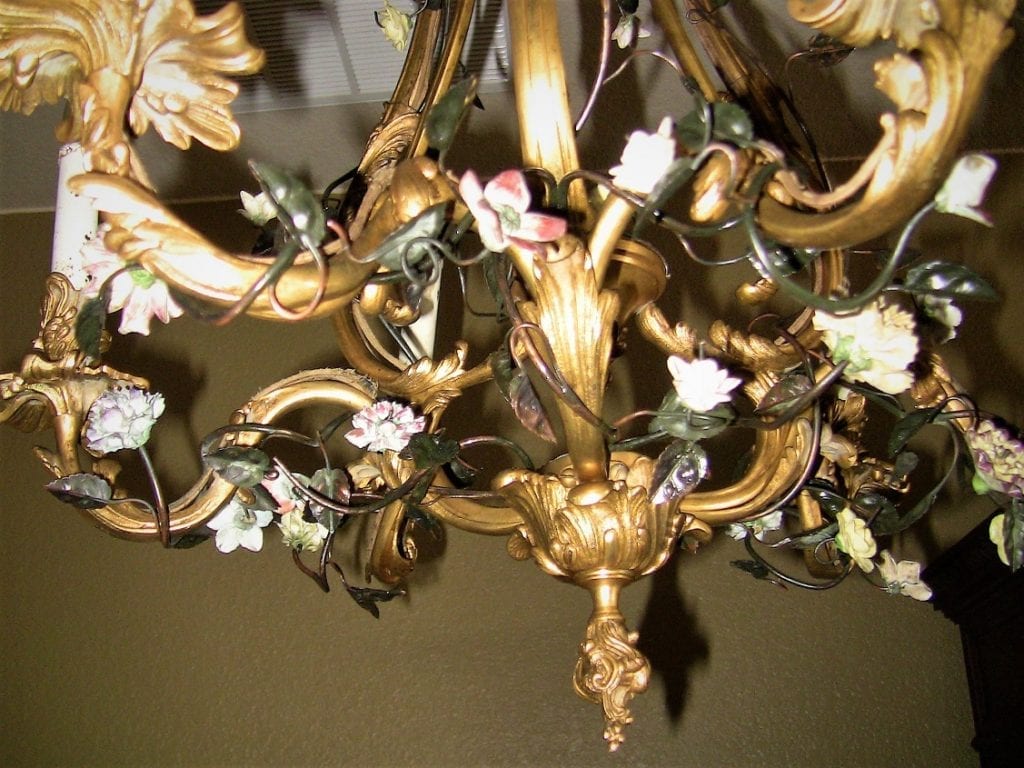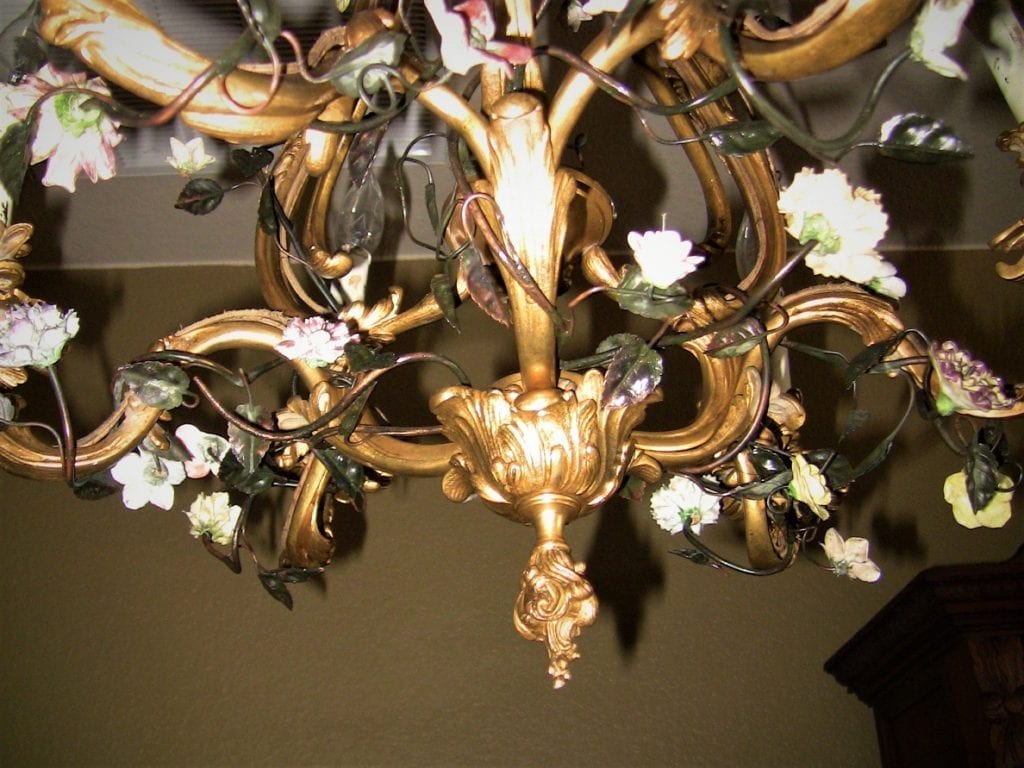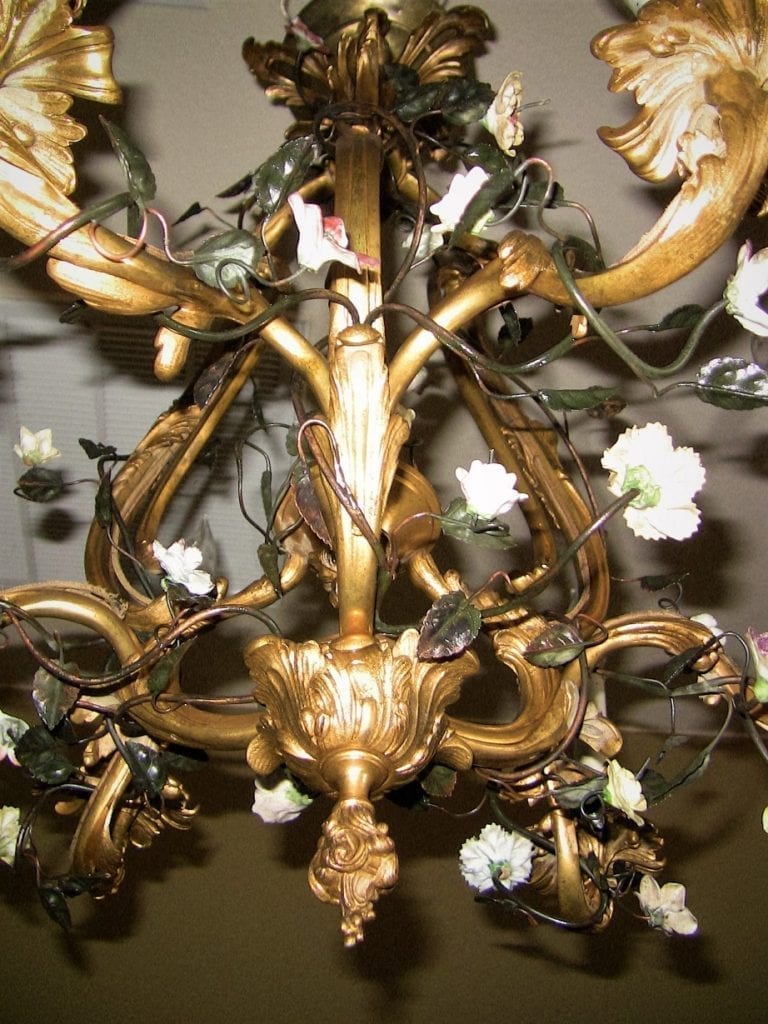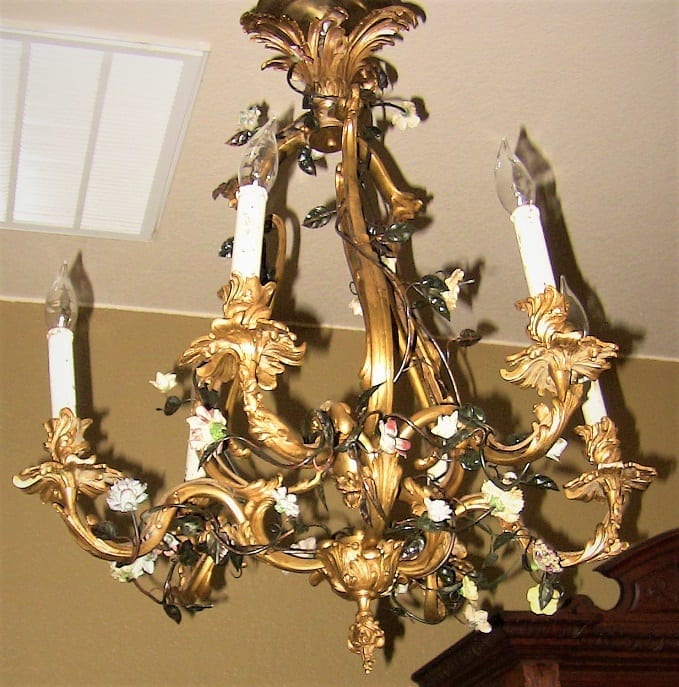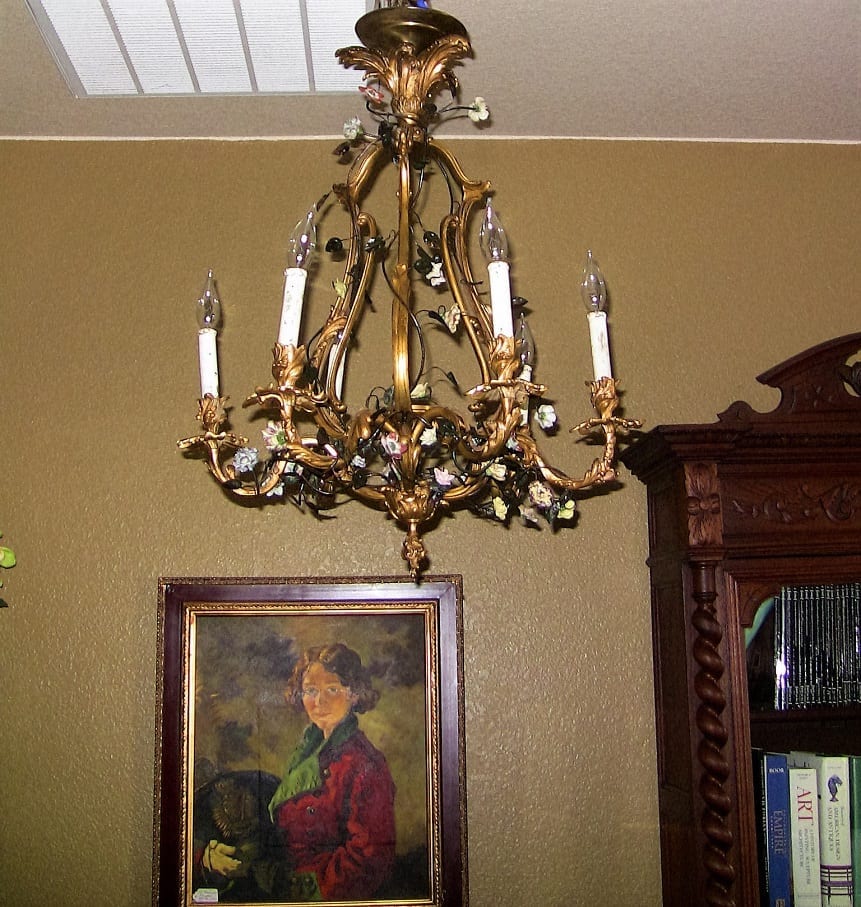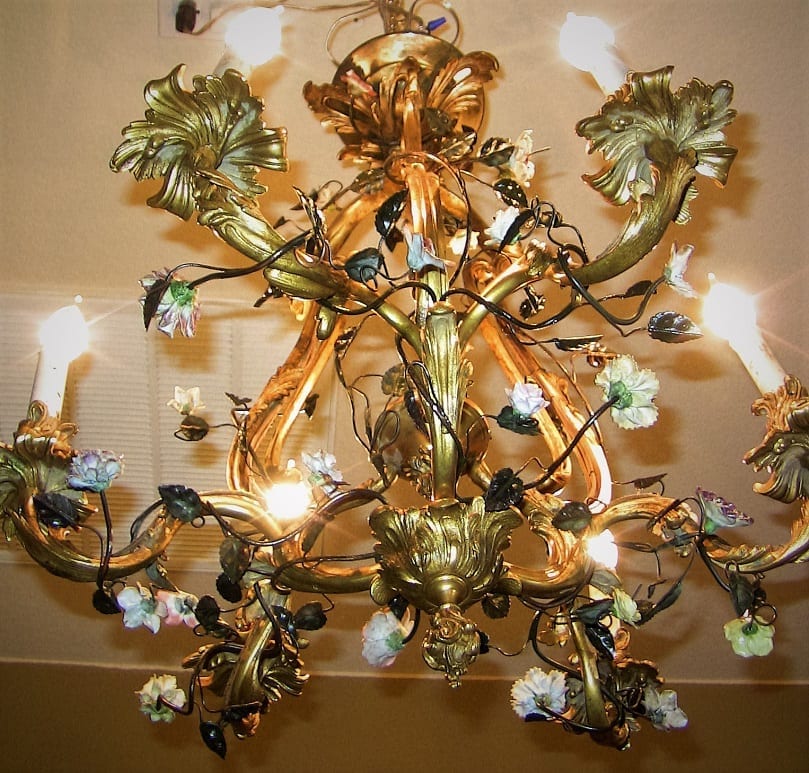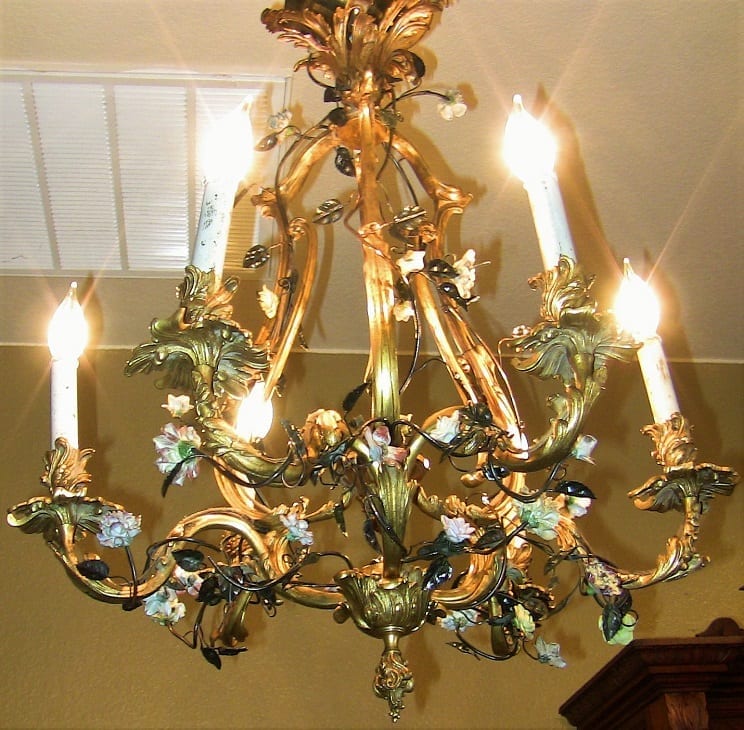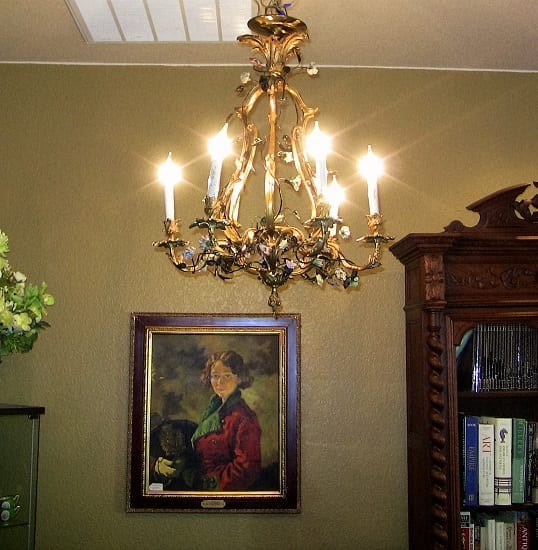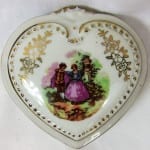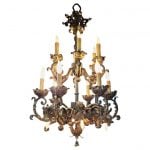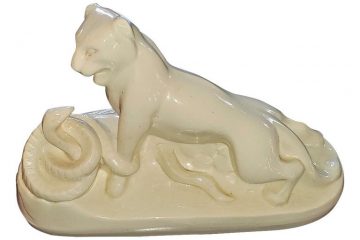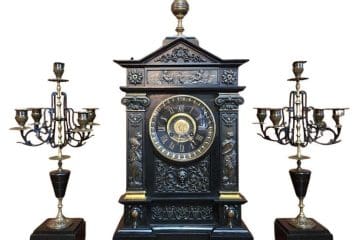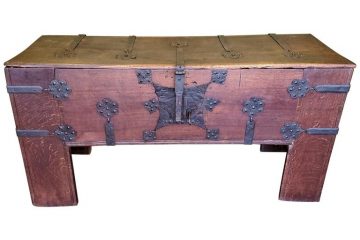19C French Gilt Bronze Chandelier with Porcelain Flowers
We have PLEASURE to present you with some of the FINEST of La BELLE EPOQUE.
This is a late 19th Century FRENCH gilt bronze 6 Branch Chandelier draped and surrounded by porcelain flowers and vines and leaves.
From circa 1885.
This is part of Dallas Private Collection.
This is a CLASSIC French Chandelier of the Belle Epoque period.
The Belle Époque or La Belle Époque (French pronunciation: [bɛlepɔk]; French for “Beautiful Era”) was a period of Western European history. It is conventionally dated from the end of the Franco-Prussian War in 1871 to the outbreak of World War I in around 1914. Occurring during the era of the French Third Republic (beginning 1870), it was a period characterized by optimism, regional peace, economic prosperity and technological, scientific and cultural innovations. In the climate of the period, especially in Paris, the arts flourished. Many masterpieces of literature, music, theater, and visual art gained recognition. The Belle Époque was named, in retrospect, when it began to be considered a “Golden Age” in contrast to the horrors of World War I.
In the United Kingdom, the Belle Époque overlapped with the late Victorian era and the Edwardian era. In Germany, the Belle Époque coincided with the Wilhelminism; in Russia with the reigns of Alexander III and Nicholas II. In the newly-rich United States, emerging from the Panic of 1873, the comparable epoch was dubbed the Gilded Age. In Brazil it started with the end of the Paraguayan War, and in Mexico the period was known as the Porfiriato.
The French public’s nostalgia for the Belle Époque period was based largely on the peace and prosperity connected with it in retrospect. Two devastating world wars and their aftermath made the Belle Époque appear to be a time of joie de vivre (joy of living) in contrast to 20th century hardships. It was also a period of stability that France enjoyed after the tumult of the early years of the French Third Republic, beginning with France’s defeat in the Franco-Prussian War, the Paris Commune, and the fall of General Georges Ernest Boulanger. The defeat of Boulanger, and the celebrations tied to the 1889 World’s Fair in Paris, launched an era of optimism and affluence. French imperialism was in its prime. It was a cultural center of global influence, and its educational, scientific and medical institutions were at the leading edge of Europe.
It was not entirely the reality of life in Paris or in France, however. France had a large economic underclass who never experienced much of the Belle Époque’s wonders and entertainments. Poverty remained endemic in Paris’s urban slums and rural peasantry for decades after the Belle Époque ended. The Dreyfus Affair exposed the dark realities of French anti-Semitism and government corruption. Conflicts between the government and the Roman Catholic Church were regular during the period. Some of the artistic elite saw the Fin de siècle in a pessimistic light.
Those who were able to benefit from the prosperity of the era were drawn towards new forms of light entertainment during the Belle Époque, and the Parisian bourgeoisie, or the successful industrialists called nouveau-riches, became increasingly influenced by the habits and fads of the city’s elite social class, known popularly as Tout-Paris (“all of Paris”, or “everyone in Paris”). The Casino de Paris opened in 1890. For Paris’s less affluent public, entertainment was provided by cabarets, bistros and music halls.
The Moulin Rouge cabaret is a Paris landmark still open for business today. The Folies Bergère was another landmark venue. Burlesque performance styles were more mainstream in Belle Époque Paris than in more staid cities of Europe and America. Liane de Pougy, dancer, socialite and courtesan, was well known in Paris as a headline performer at top cabarets. Belle Époque dancers such as La Goulue and Jane Avril were Paris celebrities, who modelled for Toulouse-Lautrec‘s iconic poster art. The Can-can dance was a popular 19th-century cabaret style that appears in Toulouse-Lautrec’s posters from the era.
The Eiffel Tower, built to serve as the grand entrance to the 1889 World’s Fair held in Paris, became the accustomed symbol of the city, to its inhabitants and to visitors from around the world. Paris hosted another successful World’s Fair in 1900, the Exposition Universelle (1900). Paris had been profoundly changed by the French Second Empire reforms to the city’s architecture and public amenities. Haussmann’s renovation of Paris changed its housing, street layouts, and green spaces. The walkable neighbourhoods were well-established by the Belle Époque.
Cheap coal and cheap labor contributed to the cult of the orchid and made possible the perfection of fruits grown under glass, as the apparatus of state dinners extended to the upper classes. Exotic feathers and furs were more prominently featured in fashion than ever before, as haute couture was invented in Paris, the center of the Belle Époque, where fashion began to move in a yearly cycle. In Paris, restaurants such as Maxim’s Paris achieved a new splendor and cachet as places for the rich to parade. Maxim’s Paris was arguably the city’s most exclusive restaurant. Bohemian lifestyles gained a different glamour, pursued in the cabarets of Montmartre.
French cuisine continued to climb in the esteem of European gourmets during the Belle Époque. The word “ritzy” was invented during this era, referring to the posh atmosphere and clientele of the Hôtel Ritz Paris. The head chef and co-owner of the Ritz, Auguste Escoffier, was the pre-eminent French chef during the Belle Époque. Escoffier modernized French haute cuisine, also doing much work to spread its reputation abroad with business projects in London in addition to Paris. Champagne was perfected during the Belle Époque. The alcoholic spirit absinthe was cited by many Art Nouveau artists as a muse and inspiration and can be seen in much of the artwork of the time.
Large public buildings such as the Opéra Garnier devoted enormous spaces to interior designs as Art Nouveau show places. After the mid-19th century, railways linked all the major cities of Europe to spa towns like Biarritz, Deauville, Vichy, Arcachon and the French Riviera. Their carriages were rigorously divided into first-class and second-class, but the super-rich now began to commission private railway coaches, as exclusivity as well as display was a hallmark of opulent luxury.
Link: https://en.wikipedia.org/wiki/Belle_%C3%89poque
French porcelain has a history spanning a period from the 17th century to the present.
After this initial period, up to the end of the 18th century, French porcelain manufactories would progressively abandon their Chinese and Japanese designs, to become more French in character. Vincennes soft-paste porcelain started to display original French inspiration towards its last years of operation, after which the abundant, varied, and original productions of Sèvres porcelain continued the trend.
Porcelain production further developed with Limoges porcelain, a type of hard-paste porcelain produced by factories near the city of Limoges, France. The manufacturing of hard-paste porcelain in Limoges was established in 1771 following the discovery of local supplies of kaolin and a material similar to petuntse in the economically distressed area at Saint-Yrieix-la-Perche, near Limoges.
In parallel, soft-paste porcelain continued to be manufactured however, as it was less expensive to produce.
Link: https://en.wikipedia.org/wiki/French_porcelain
THIS IS A REALLY ‘HIGH-END’ QUALITY ANTIQUE
ONE FOR THE SERIOUS COLLECTOR OF FINE THINGS
19C French Gilt Bronze Chandelier with Porcelain Flowers.
Provenance: From a Private Dallas Collection.
Dimensions: 31 inches Tall and diameter of 24 inches at base
Condition: Good Original Condition. Some missing or broken flowers, but not significant.
